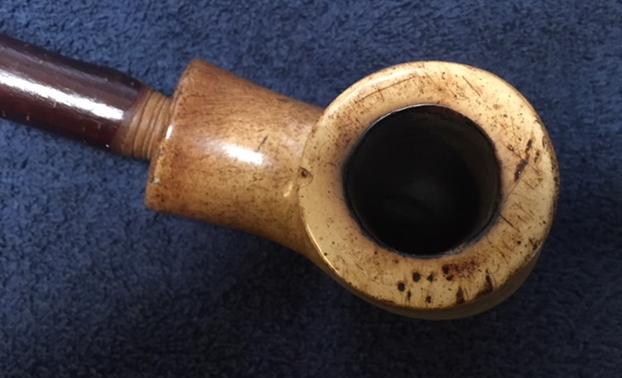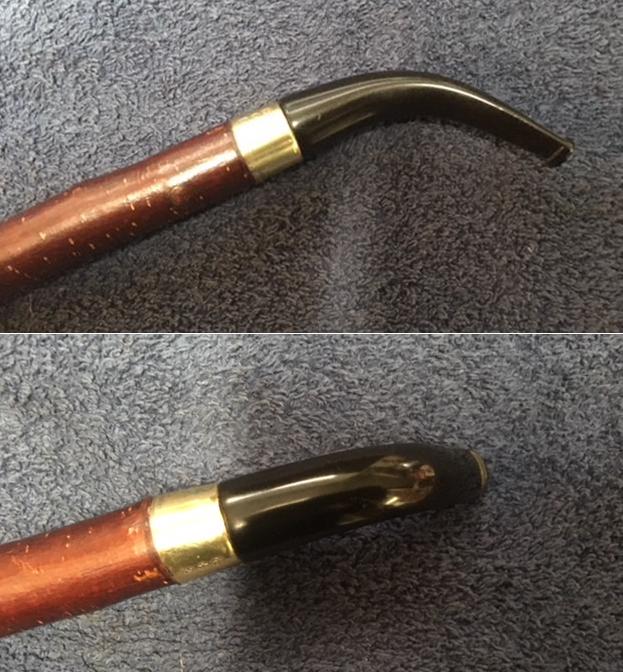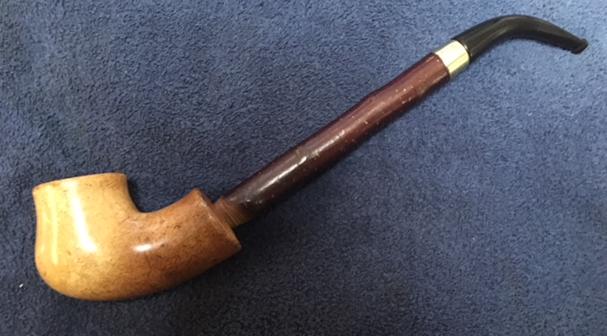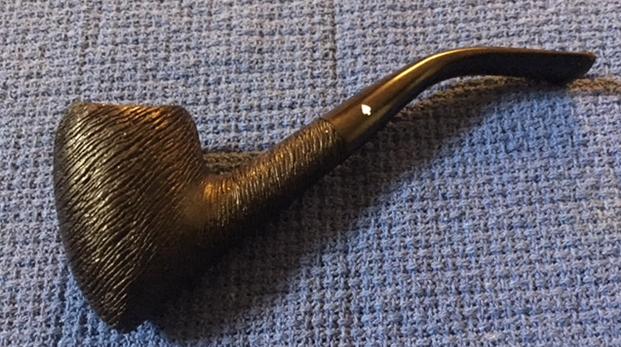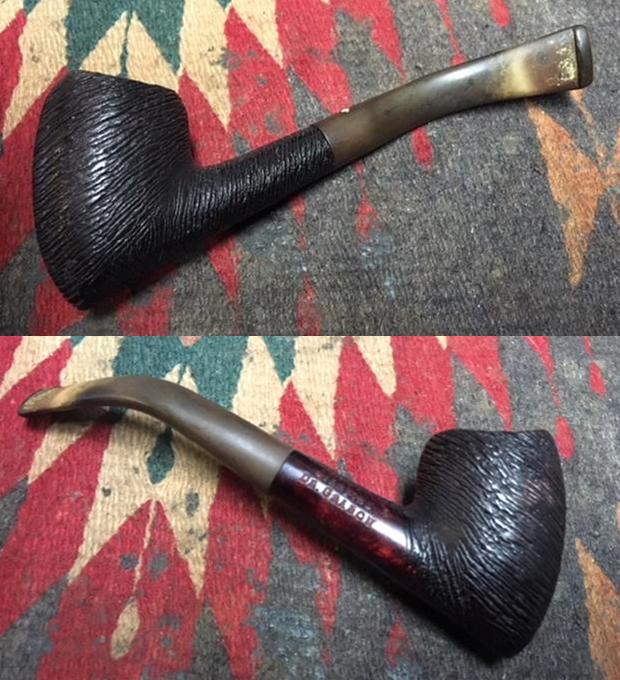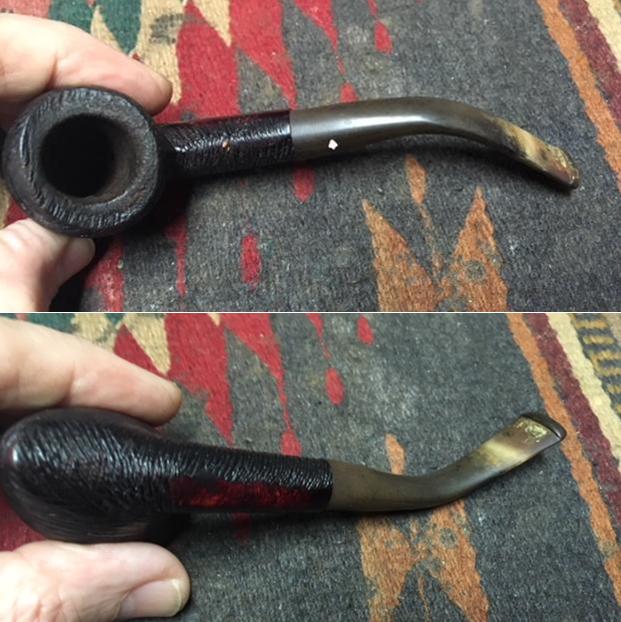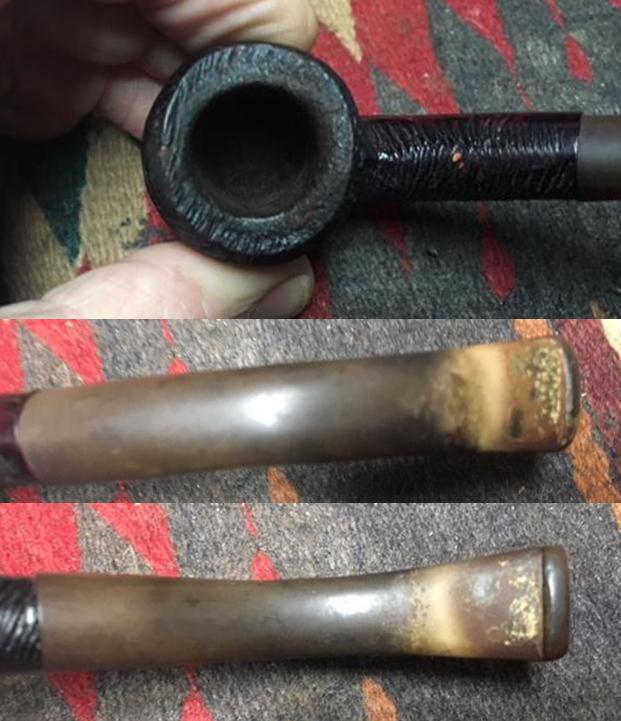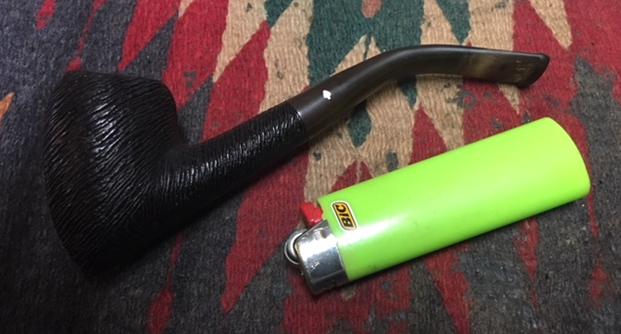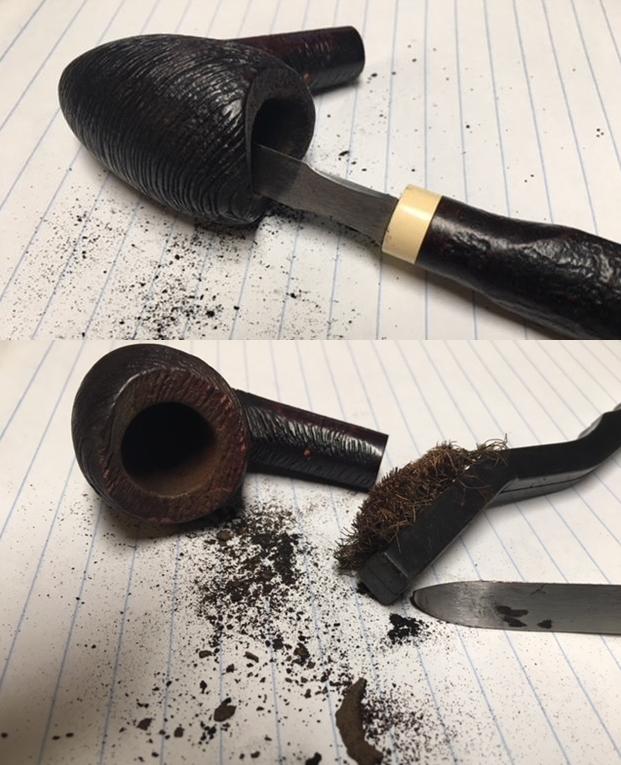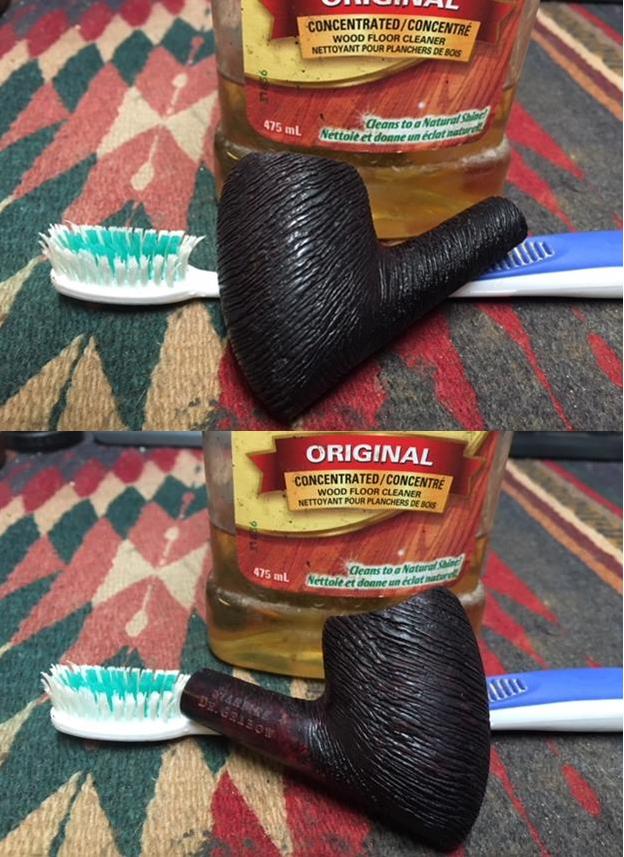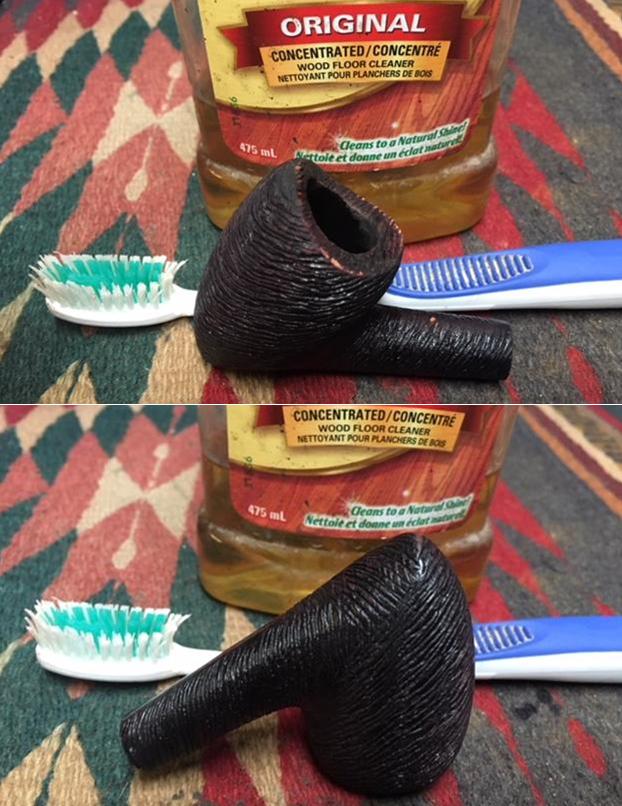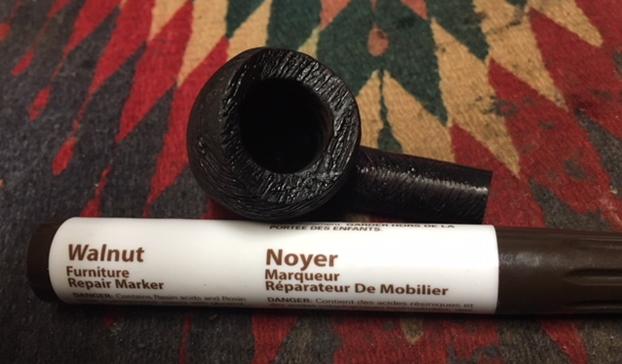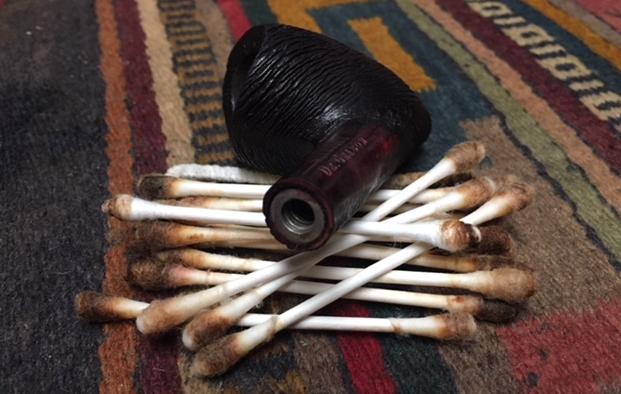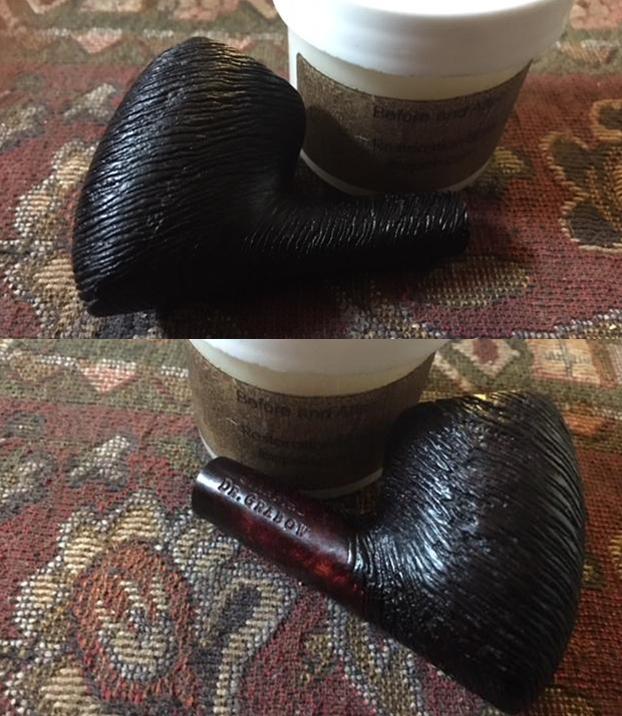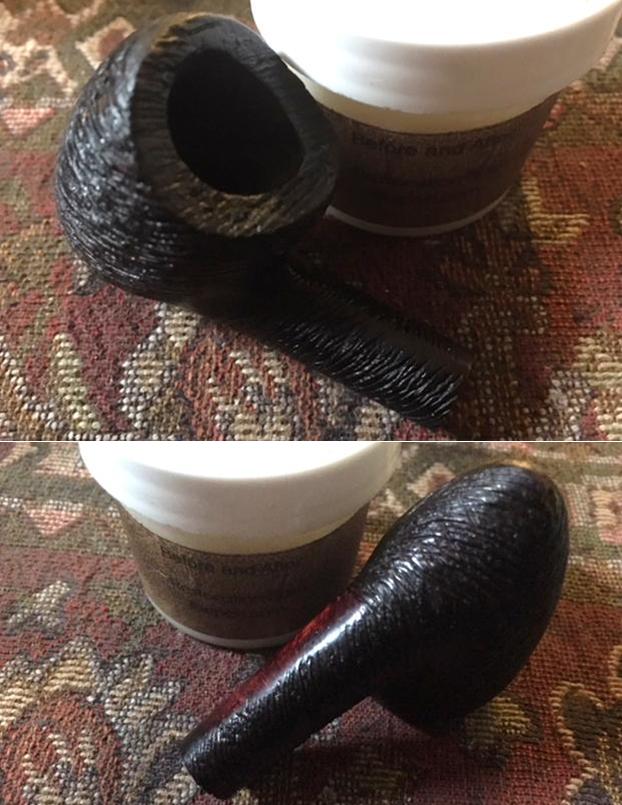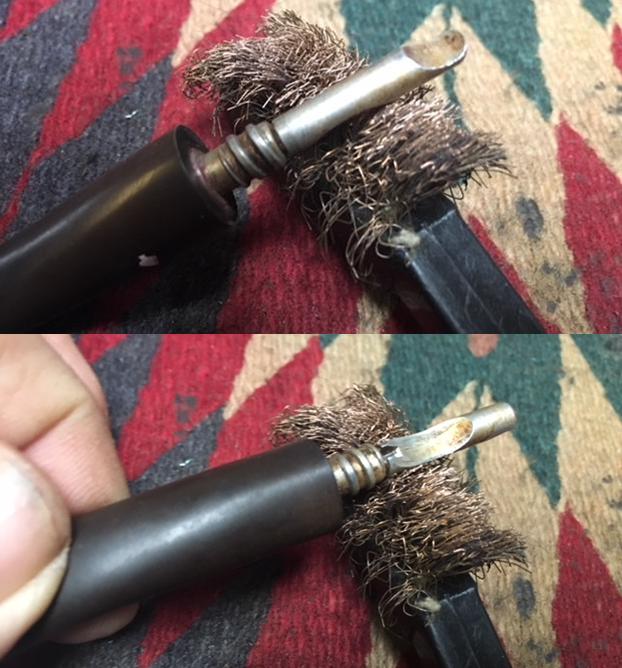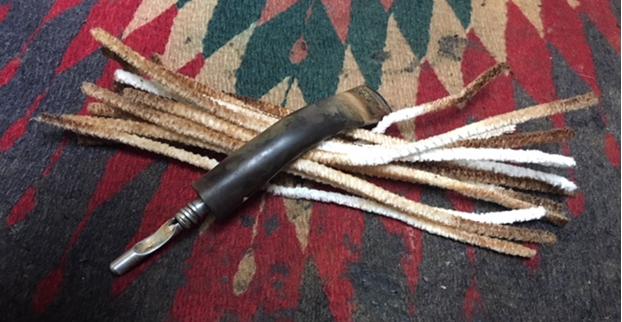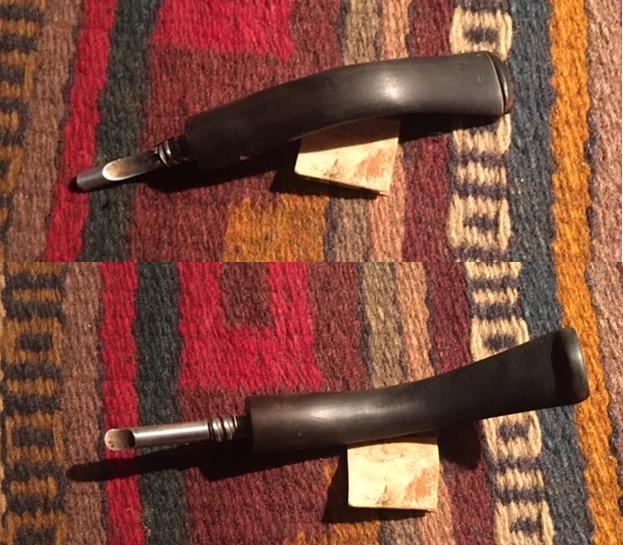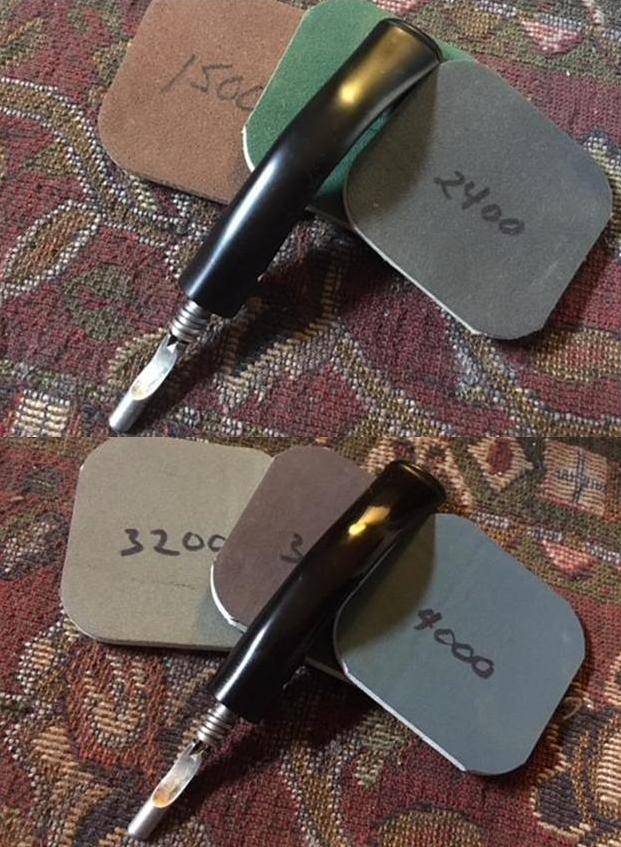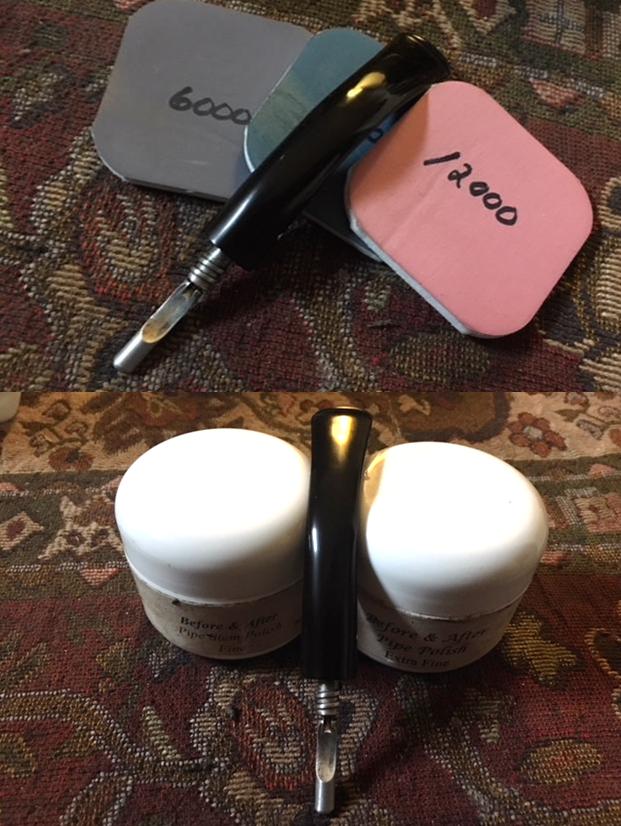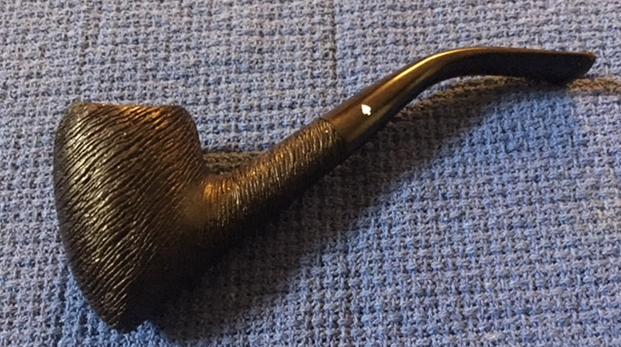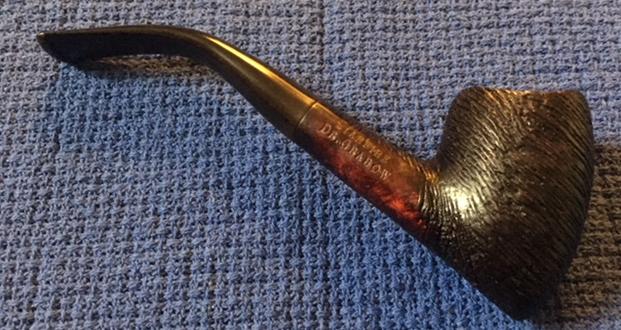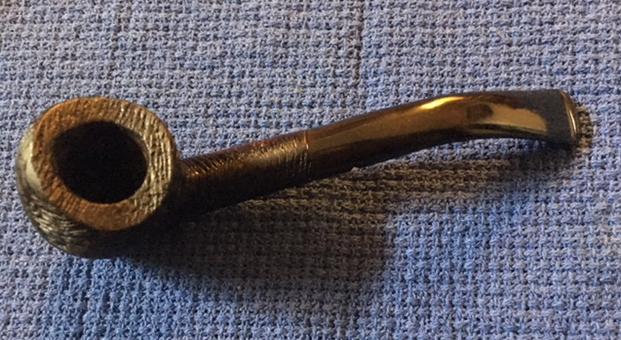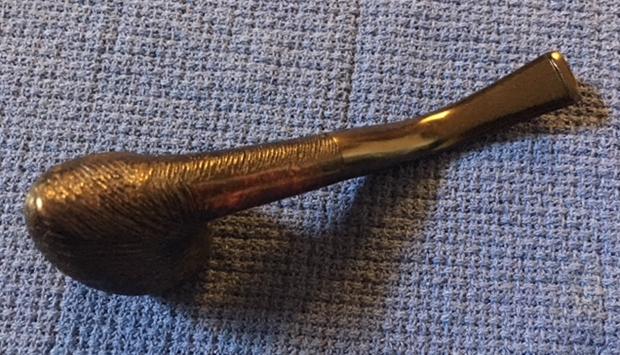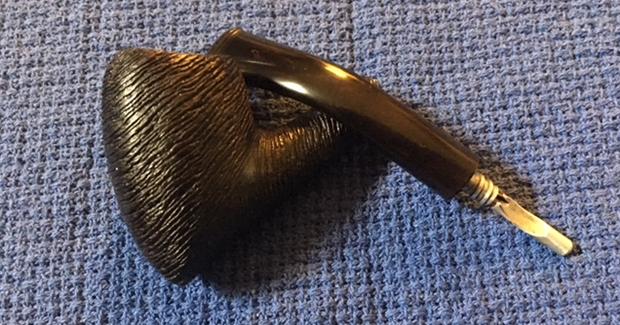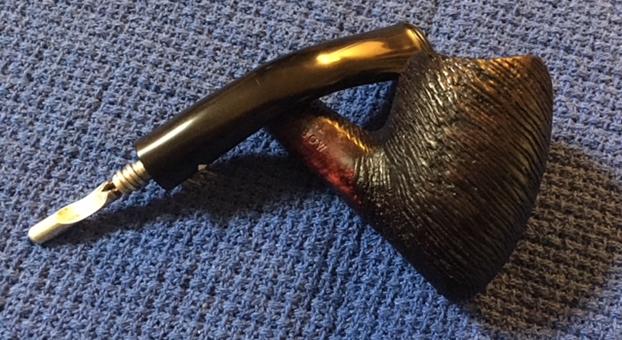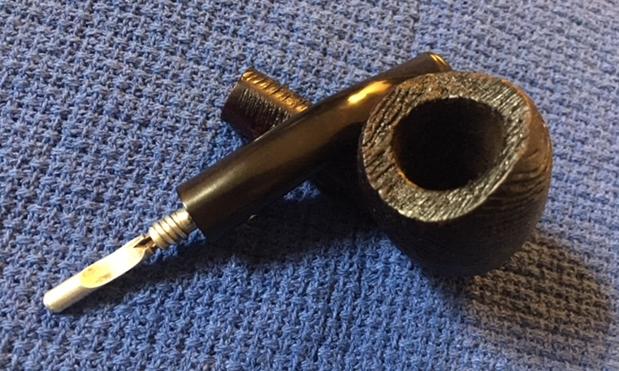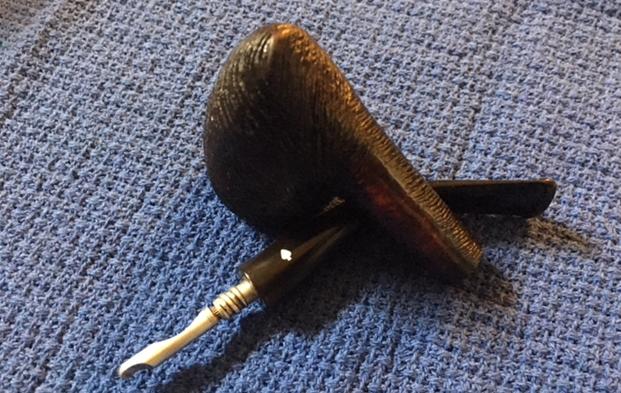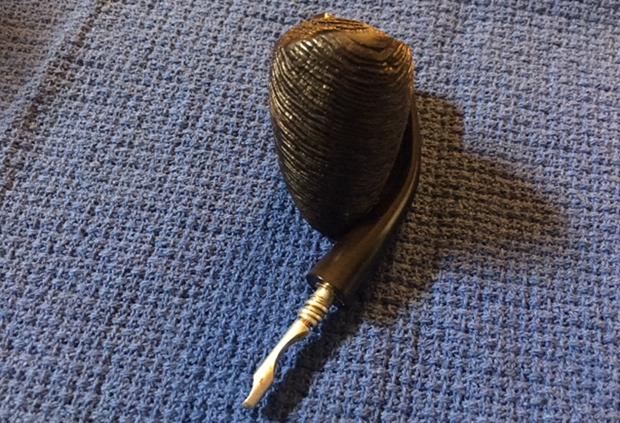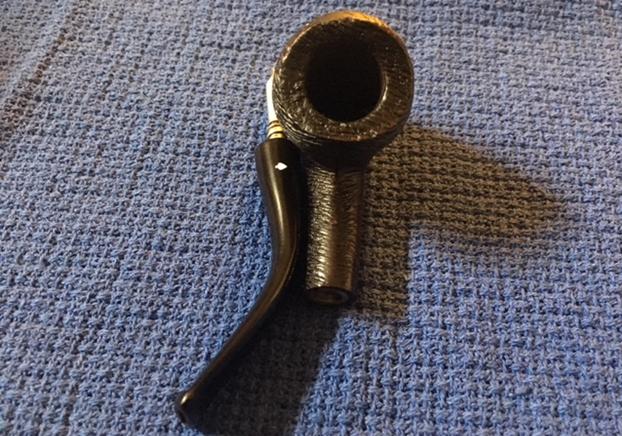Blog by Steve Laug
I have repaired three of the pipes from the seven of his Grandfather’s pipes that Paresh sent me. It is an interesting assortment of older pipes that come from the period of 1937-1950s. His Grandfather worked for the Indian Railroad and was a pipeman. Paresh is also a pipeman and only recently learned that his Grandfather smoked a pipe. The fourth pipe is an antique Meerschaum pipe with a Cherrywood shank and vulcanite stem. It is what is known as a Kalmasch Meerschaum pipe. It is a large pipe – 12 inches long and 2 ½ inches tall. I took the following photos of the pipe before I stated to work on it. It was in excellent condition, very clean with just a thin bit of lava and tar on the top of the rim. The inner and outer edge of the bowl was in excellent condition. I took some photos below show the pipe as it arrived.
The photos of the pipe show the parts. Abha, Paresh’s wife had cleaned it up and sent the parts of the pipe individually packaged for safe shipping. The bowl was a heavy piece of meerschaum that had already begun to take on colour in the shank and up the sides of the bowl. The Cherrywood shank had one end threaded and the other end carved into a cone shape. The cone shaped end had the same angles as the mortise in the meerschaum bowl. The vulcanite stem was threaded and was made to be turned onto the threaded end of the cherry wood shank. You can see in the photos below how far down the threads the stem could be turned as they are darkened. There is about a ½ in gap between the stem and the shank when the stem is turned onto the shank. That will need to be addressed in the restoration.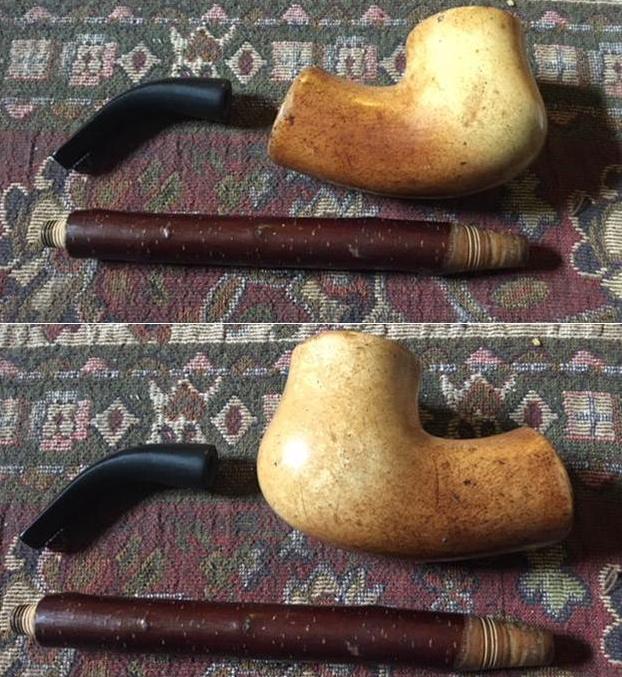
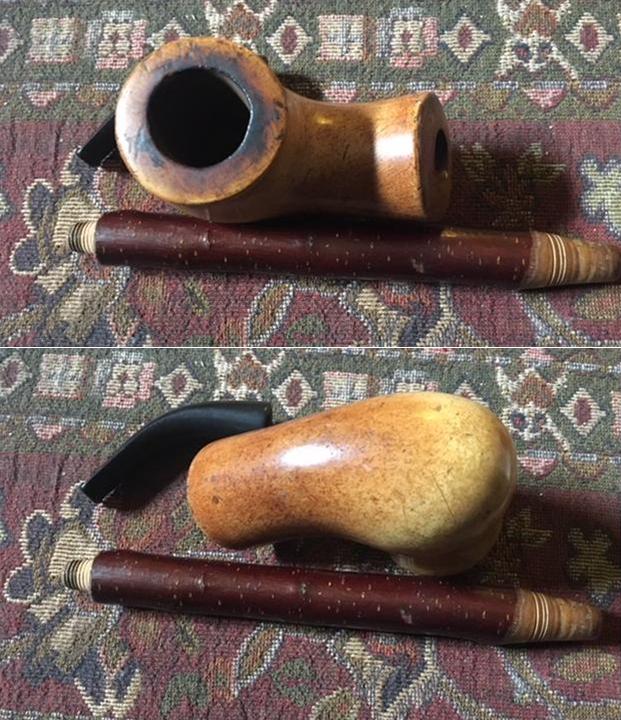 The rim top has some lava that had overflowed from the bowl and darkened the gouges in the surface and was built up around the back side of the bowl. It is not too thick and hard. It will need to be scraped off when I started the cleaning. The outer edge of the bowl looks pretty good with a little wear on the front edge and back right side. The bowl was very clean and smooth on the inside. I also took a close up photos of both sides of the stem. You can see that there is light tooth chatter on the top and underside of the stem just in front of the button. The surface of the stem is lightly oxidized and pitted.
The rim top has some lava that had overflowed from the bowl and darkened the gouges in the surface and was built up around the back side of the bowl. It is not too thick and hard. It will need to be scraped off when I started the cleaning. The outer edge of the bowl looks pretty good with a little wear on the front edge and back right side. The bowl was very clean and smooth on the inside. I also took a close up photos of both sides of the stem. You can see that there is light tooth chatter on the top and underside of the stem just in front of the button. The surface of the stem is lightly oxidized and pitted.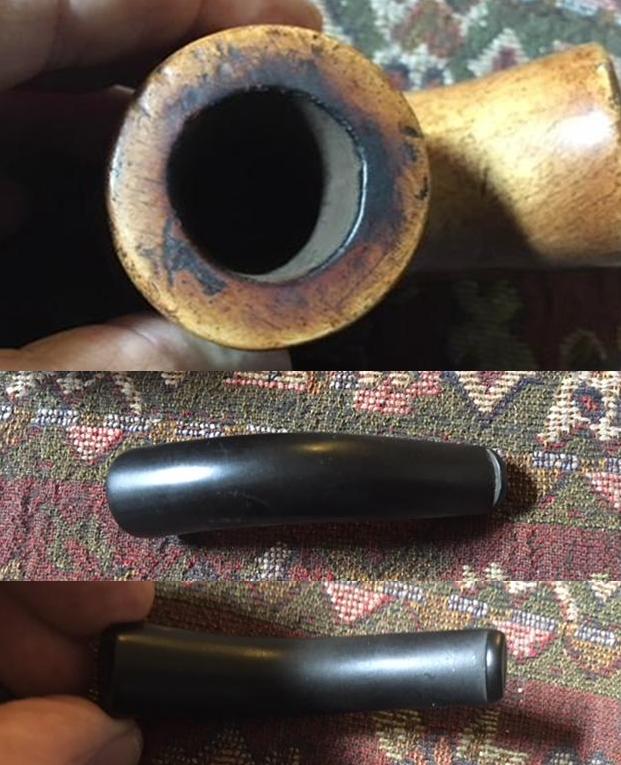 I took close up photos of both ends of the Cherrywood shank. The first photo shows the threaded end where the stem is screwed onto the shank. The first portion is threaded and the bottom half is partly threaded. It appears to me that there was originally a space between the stem and the rest of the shank end. The other end of the shank shows the conical shaping that matches the taper of the inside of the mortise in the bowl portion of the pipe.
I took close up photos of both ends of the Cherrywood shank. The first photo shows the threaded end where the stem is screwed onto the shank. The first portion is threaded and the bottom half is partly threaded. It appears to me that there was originally a space between the stem and the rest of the shank end. The other end of the shank shows the conical shaping that matches the taper of the inside of the mortise in the bowl portion of the pipe. 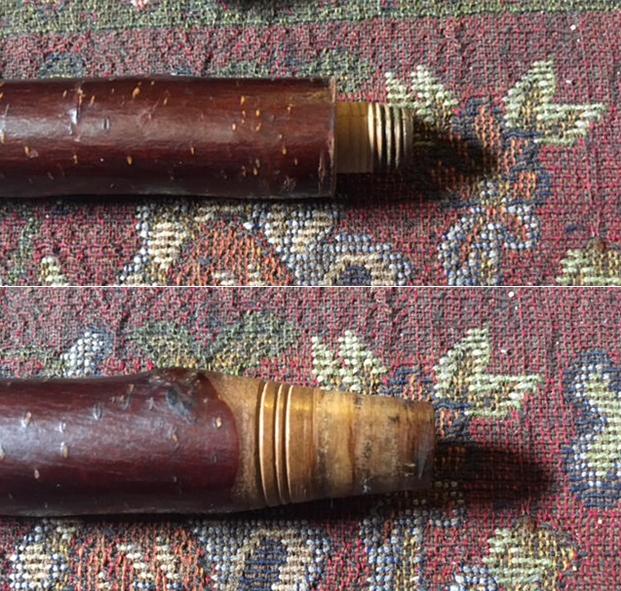 I put the pieces back together and took photos of the pipe to show what it looked like. You can see the fit of the shank to the bowl. It is snug and it will not need to be changed. The stem is screwed in place on the shank and you can see the ½ inch gap between the stem and the shank.
I put the pieces back together and took photos of the pipe to show what it looked like. You can see the fit of the shank to the bowl. It is snug and it will not need to be changed. The stem is screwed in place on the shank and you can see the ½ inch gap between the stem and the shank.
 As I have mentioned in the previous three restorations, I always enjoy getting some background information on the pipeman whose pipes I am restoring when I am working estate pipes from the family members. If you have followed rebornpipes for a while you have read a few of these summaries from estates like Kathy’s Dad, Barry’s Dad and Farida’s Dad. Each of them did a great job summarizing their fathers’ estates. Since the next group of seven pipes that I will be working came to from India and belonged to the Grandfather of Paresh, I asked him to write a short tribute to his Grandfather. What follows is his writeup.
As I have mentioned in the previous three restorations, I always enjoy getting some background information on the pipeman whose pipes I am restoring when I am working estate pipes from the family members. If you have followed rebornpipes for a while you have read a few of these summaries from estates like Kathy’s Dad, Barry’s Dad and Farida’s Dad. Each of them did a great job summarizing their fathers’ estates. Since the next group of seven pipes that I will be working came to from India and belonged to the Grandfather of Paresh, I asked him to write a short tribute to his Grandfather. What follows is his writeup.
Respected Sir,
Now that the first batch of my Grandfather’s pipes has reached you, I would like to share my memories of him with you, the aim being to provide you with an insight to his personality, the era in which he lived, and a brief history associated with the pipes that I have inherited from him.
My Grandfather, Ananta (named after an exotic seasonal white flower having lovely fragrance), was born in a small coastal town of Konkan region of Maharashtra, India, in 1918. These were very turbulent times when India’s freedom struggle against British rule was gathering momentum and the atmosphere was charged with “Quit India Movement”. Having completed his graduation from Bombay, he joined Railways in 1937. This also marked the beginning of his journey into the world of pipe smoking!!!!!
Having seen his potential, in 1945, he was sponsored by the Government to visit England, for gaining further experience and expertise in his profession. This was a period when India’s Independence was round the corner and efforts were being made to train Indians for various administrative appointments in future Independent India. He returned back to India after a year, in 1946 and with him came some pipes that he had purchased in England. I believe a few of his Petes, Barlings, Charatans and GBDs are from this visit.
In 1947, when the British finally left India for good, my Grandfather was gifted pipes by his British peers, subordinates and Superior Officers as a parting gift. He stayed in touch with a few of them over all these years, even visiting them in 1959-60. Some of his later era Charatans and Barlings and Petes are from this trip. He quit smoking in early 1970s (before I was even born!!!!) and his pipes were packed up. There were a number of pipes which were used as TINDER for lighting fires (CAN’T BELIEVE IT…… I have not overcome my grief of this loss till date!!!!!) due to ignorance!!!!!!
My Grandfather was a very strict disciplinarian and temperamental (I did not know this as he was neither when dealing with me as I am the youngest of all his grandchildren!!!!!! He was always the most understanding and loving person in my life). I later learned that in his office, he was not to be disturbed when his pipe was lit, as he would be in his thinking/ contemplating mode while it was just the opposite as he lit his pipe in the evening while at home, when he would be at his relaxed best!!!!.
The interesting part is that neither of us knew that we each smoked a pipe until after his demise in Jan 2018!!!! In our culture, to this day, smoking or alcohol consumption is socially never talked about (mute acceptance!!!). It was during his last rites that absent mindedly I lighted my pipe and looking into the flickering flames of his funeral pyre, remembered and recollected all the wonderful memories and talks that we had shared. No one said a word to me about my lighting up a pipe!!!!!! Immediately thereafter, I rejoined my duty station. A few days later, my wife, Abha, received a box from my Uncle with a note that said “Grandfather would have loved Paresh to have these”. This box contained a collection of his fountain pens and 8-10 of his pipes (since then as my folks are winding up his belongings, I have received 2-3 packets and a large number of pipes, some in decent condition and some in unspeakable state). Abha immediately messaged me with pictures of these pipes and pens. I had been collecting and restoring (no major repairs, though) fountain pens since long and immediately recognized some of them as highly collectibles, however, pipes were a totally different ball game! I was inexperienced with no knowledge/ information regarding various brands/ pipe makers, shapes and materials. I knew nothing about the value of these pipes, nothing about pipe restorations, nothing about caring for them; I mean zero knowledge about collecting pipes. I smoked some real cheap Chinese pipes which were readily and unfortunately, the only ones, available in India and some inexpensive pipes from eBay India!!!!! Also regular pipe cleaning, pipe rotation, pipe cleaners and such things were unknown to me.
Thus, to know more about the REAL pipes, I embarked upon the journey of exploring finer nuances of pipe brands/ makers, their history and watching “How to videos” on packing a pipe, cleaning, repairing and caring for ones pipes. I found it extremely interesting and satisfying. It was while meandering through this confusing quagmire of pipe world that I came across rebornpipes.com website and eventually established contact with you, Mr Steve, who has since been my mentor, guide and GURU, making this journey a wonderful and satisfying experience.
Sir, there is one more thing that I need to thank you for and that is when you asked me to write a brief about my grandfather and his pipes, I realized how little I knew about him, in fact, knew nothing, as I was not even aware that he was a “pipeman” as no one in my family ever spoke about it being taboo subject and since he had quit a long time before I was even born!!!! This led me to ask the elders in my family, questions on the subject and came to know the above details. I cannot thank you enough for prodding me to get to know my grandfather and his pipes a lot better. Sir, these pipes of his, with your help and guidance, will remain with me forever in mint condition……
Thanks Paresh for this great descriptive take of your Grandfather. It really gives me a sense of the pipes that you have sent me and what they meant to him. It is obvious from the variety of pipes that you sent and the overall condition that he knew how to choose good quality pipes and obviously enjoyed smoking them throughout most of his life.
Paresh’s wife Abha cleaned all of the pipes before she sent them to me here in Canada and did an amazing job cleaning them up. She reamed the bowls, cleaned the rims and scrubbed the exterior of the pipes and the stems with Murphy’s Oil Soap and cleaned off the buildup on the stems. On this pipe she had removed the cake in the bowl and done a great job cleaning the exterior of the bowl. The cherrywood shank had also been cleaned. The stem was lightly oxidized on both sides and had light chatter and pitting.
I polished the top of the bowl with micromesh sanding pads to remove all of the tar and lava that was on the surface. I wet sanded it with 1500-2400 grit pads and dry sanded with 3200-12000 grit pads. I wiped the bowl down with a damp cloth to remove the dust that was left behind by the sanding. While I was working on the bowl top I also worked over the sides and bottom of the bowl to polish them as well.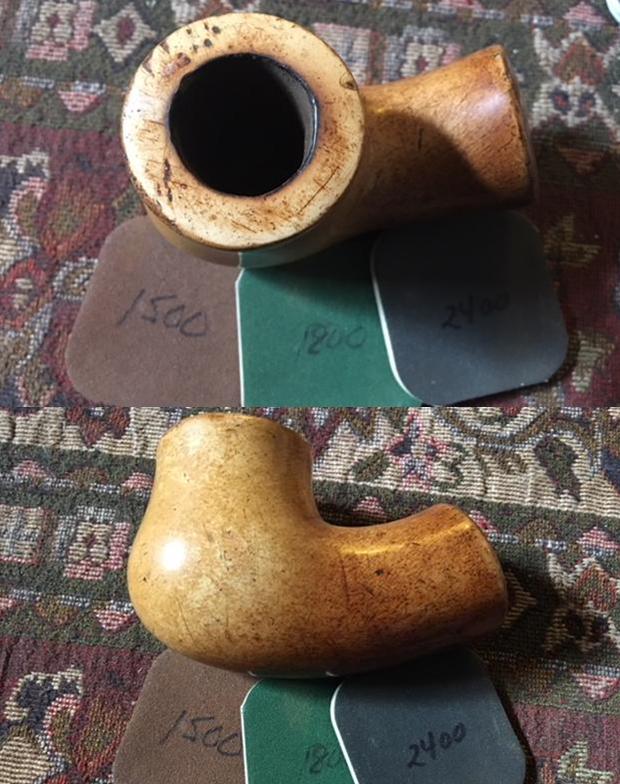
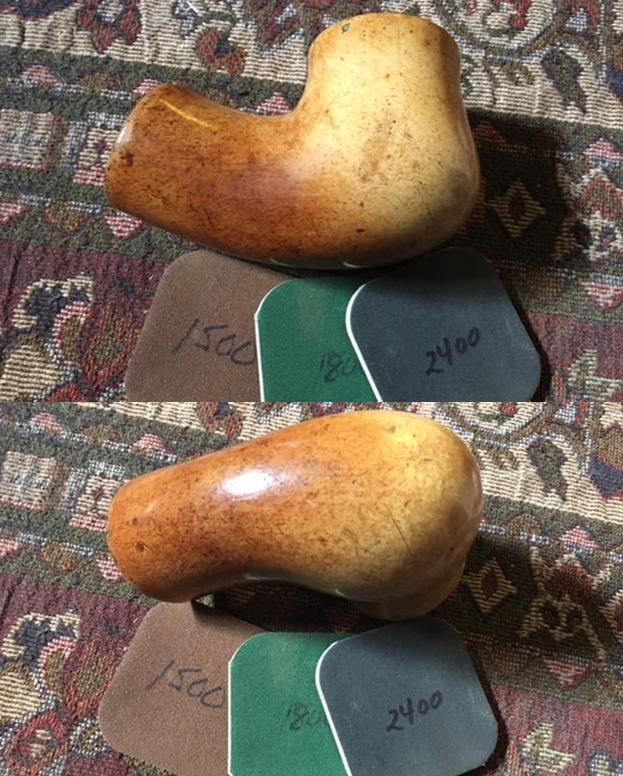
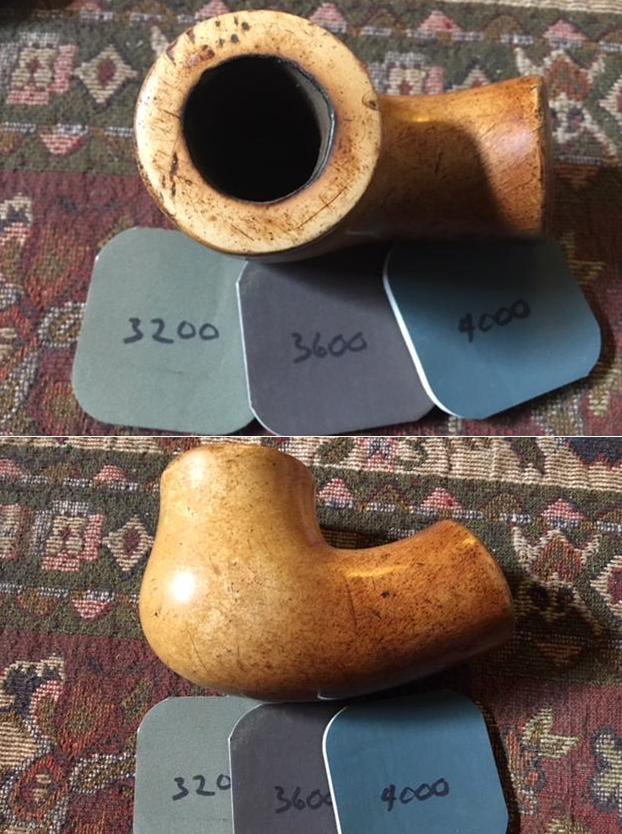

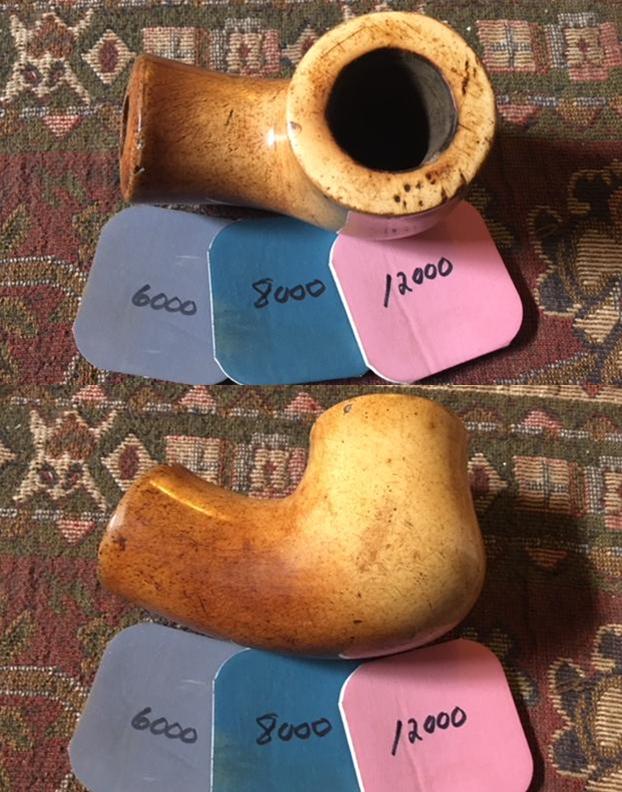
 I went through my box of bands and ferrules and found a brass ferrule that would work well to fill the gap between the shank and the stem when it was put in place. I put it on the end of the shank and screwed the stem in place. I took photos of the shank with the stem in place. It still needed to be polished and the edge below the ferrule will need to be smoothed out and touched up with stain to blend in the edge. However, you can see what it will look like when it is finished.
I went through my box of bands and ferrules and found a brass ferrule that would work well to fill the gap between the shank and the stem when it was put in place. I put it on the end of the shank and screwed the stem in place. I took photos of the shank with the stem in place. It still needed to be polished and the edge below the ferrule will need to be smoothed out and touched up with stain to blend in the edge. However, you can see what it will look like when it is finished.
 I polished the ferrule with micromesh sanding pads to polish off the tarnish. I wet sanded it with 1500-2400 grit pads and dry sanded it with 3200-12000 grit pads. I polished it with a jeweler’s cloth and the shine really stood out. I took photos of the band after polishing.
I polished the ferrule with micromesh sanding pads to polish off the tarnish. I wet sanded it with 1500-2400 grit pads and dry sanded it with 3200-12000 grit pads. I polished it with a jeweler’s cloth and the shine really stood out. I took photos of the band after polishing.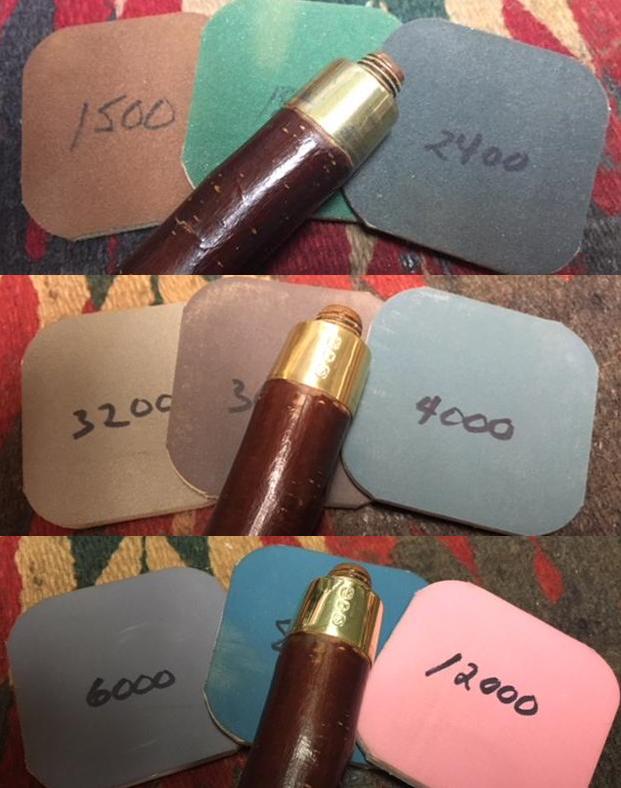 I worked Before & After Restoration Balm deep into the Cherrywood shank to clean, enliven and protect it. I worked it into the finish with my fingertips. I worked it into the threaded and conical end. I set it aside for a few minutes to let the balm work. I wiped it off and buffed it with a soft cloth to polish it. The bark on the shank really began to have a deep shine. I took a photo of the shank with the polish ferrule and polished Cherrywood at this point to mark the progress in the restoration. The shank is really beginning to look good.
I worked Before & After Restoration Balm deep into the Cherrywood shank to clean, enliven and protect it. I worked it into the finish with my fingertips. I worked it into the threaded and conical end. I set it aside for a few minutes to let the balm work. I wiped it off and buffed it with a soft cloth to polish it. The bark on the shank really began to have a deep shine. I took a photo of the shank with the polish ferrule and polished Cherrywood at this point to mark the progress in the restoration. The shank is really beginning to look good.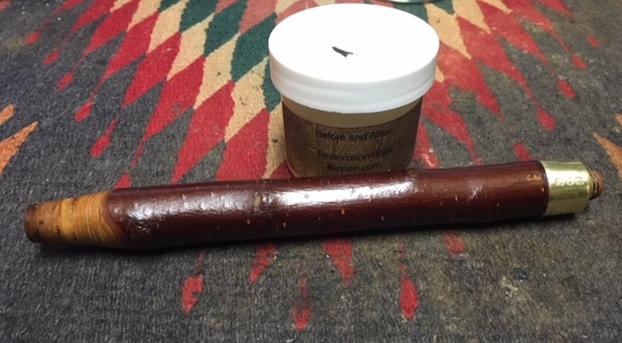 I sanded out the tooth chatter and pitting on both sides of the stem at the button with 220 grit sand paper. I polished the stem with micromesh sanding pads – wet sanding with 1500-2400 grit sanding pads and dry sanding with 3200-12000 grit pads. I wiped the stem down with Obsidian Oil after each sanding pad and set it aside to dry.
I sanded out the tooth chatter and pitting on both sides of the stem at the button with 220 grit sand paper. I polished the stem with micromesh sanding pads – wet sanding with 1500-2400 grit sanding pads and dry sanding with 3200-12000 grit pads. I wiped the stem down with Obsidian Oil after each sanding pad and set it aside to dry.

 With the stem polished I put it back on the pipe and lightly buffed the bowl and stem with Blue Diamond. I gave the Cherrywood shank and the stem several coats of carnauba wax. I gave the bowl a coat of beeswax and buffed the pipe with a clean buffing pad to raise the shine and hand buffed it with a microfiber cloth to deepen the shine. The pipe polished up pretty nicely. The finished pipe is shown in the photos below. I have three more of Paresh’s Grandfather’s pipes to finish and then I will pack them up and send across the sea to India where he can carry on the legacy. I know that he is looking forward to having them in hand and enjoying a bowl of his favourite tobacco in memory of his Grandfather. Thanks for walking through the restoration with me as I worked this pipe over.
With the stem polished I put it back on the pipe and lightly buffed the bowl and stem with Blue Diamond. I gave the Cherrywood shank and the stem several coats of carnauba wax. I gave the bowl a coat of beeswax and buffed the pipe with a clean buffing pad to raise the shine and hand buffed it with a microfiber cloth to deepen the shine. The pipe polished up pretty nicely. The finished pipe is shown in the photos below. I have three more of Paresh’s Grandfather’s pipes to finish and then I will pack them up and send across the sea to India where he can carry on the legacy. I know that he is looking forward to having them in hand and enjoying a bowl of his favourite tobacco in memory of his Grandfather. Thanks for walking through the restoration with me as I worked this pipe over. 





